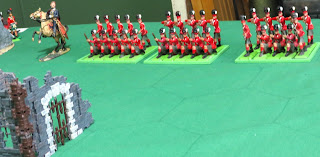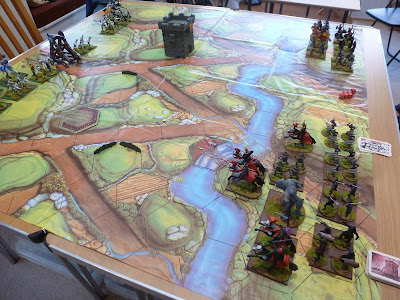Travel Battle is a boardgame designed by Michael Perry and produced by Perry Miniatures, the well known wargame figure manufacturers, it's based on battles in the Napoleonic period so Anthony and I thought we'd see how well the system translated to a tabletop wargame with 54mm toy soldiers. Here's how it went:
When I have a little money, I buy Toy Soldiers; and if I have any left, I buy food and clothes. (with apologies to:) ERASMUS
Wednesday, 23 April 2025
Travel Battle - A Napoleonic wargame with 54mm toy soldiers
Monday, 10 March 2025
Woking Games Day 2025
Last Saturday a small band of the faithful from the Little Wars Revisited group assembled in Woking for this years Games Day. The event was hosted by Mike who offered us three games using 54mm toy soldiers including Waddington's Battle of the Little Big Horn (seen on this blog previously). I took part in a Battle Masters Lord of the Rings game and here's how it went:
Wednesday, 5 March 2025
New Blog in Town!
Veteran wargamer, toy soldier collector and all round good chap, my friend Graham Apperley has started a blog, Tales from the Toy Room, and there is a link to it in the column on the right. Please take a look, you'll like what you'll see.
Also added to the bloglist today is Little Wars 1913 run by another friend, Mike Lewis, this blog has been around for more than a decade but I only discovered it yesterday so here is the link. Enjoy!
Saturday, 30 November 2024
Plastic Warrior Show 2025
The date for the 2025 Plastic Warrior Show has now been released.....
TRAVEL GUIDE
Directions to The Plastic Warrior Show
BY ROAD
From Outside London take M25, M3, A316, go over one roundabout and entrance to the winning Post is after 500 metres on your left.
From Inner London, after Richmond Circus follow A316 and continue straight on over three roundabouts. You will pass the Winning Post on your right. At the next roundabout take the fourth exit and entrance to the Winning Post will be on your left after 500 metres.
FREE PARKING. There is extensive free parking at the site and in the residential roads behind the Winning Post. The Harlequin Suite is to the right of the main building.
BY PUBLIC TRANSPORT
From Central London and the South of England by overground train (South Western Railways) from Waterloo or Clapham Junction to Whitton Station. There are eight trains an hour and the journey time is approx. 30 minutes, this is a loop line so four trains an hour run from two different platforms at Waterloo Station.
From the North of England by train to London arriving at Kings Cross, St. Pancras or Euston.
Take the London Underground Victoria line just six stops to Vauxhall and change for South Western Railways to Whitton Station as above. Whitton Station is just three minutes walk from the Winning Post. Turn left out of the station past Jubilee Avenue and Pauline Crescent, the next turning on your left is the entrance to the Winning Post.
Should you wish to take the London Underground to Richmond as in previous years, the easiest thing is to change platform and take a South Western Railways service to Whitton Station as above, (four trains an hour from Richmond, journey time eight minutes).
Alternatively you could get a black cab or a H22 bus from the taxi rank and bus stop outside the station.
Oyster cards are accepted on all London Underground lines, buses and South Western Railways to Whitton Station.
The Winning Post Inn
Opens from 08.00 to 11.00 serving breakfast or coffee for those who arrive early. The pub serves drinks from 11.00 and lunches from 12.00. There is a cashpoint on site but Whitton town centre, with a full range of shops and banks, is just three minutes walk from the hall.
Within the Winning Post complex is a Premier Inn travel hotel for those who want to break their journey and stay overnight.
Saturday, 2 November 2024
Lionheart - a medieval wargame with 54mm toy soldiers
Lionheart is a medieval boardgame published by Parker Brothers in 1997, played on a square grid with 25mm pieces the aim is to capture the enemy King or destroy all of his army, it plays a bit like a game of chess. We thought we'd try out the basic game to see if it would translate to a wargame with 54mm toy soldiers, here's how it went:

























